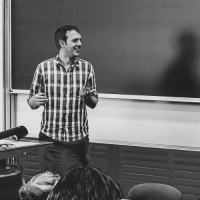Today's post is by Tom McClelland and Monika Dunin-Kozicka on their recent paper, "Affording Imagination" (Philosophical Psychology, 2024).
 |
| Tom McClelland |
Our perception of our environment includes possibilities for action known as ‘affordances’. You might, for instance, perceive a ladder as affording climbing, an apple as affording eating or a teapot as affording pouring. In these examples the actions afforded are actions you do with your body, but affordance perception might also encompass opportunities to do things with your mind. In particular, you might perceive affordances to imagine. Do you perceive a wrapped present as affording imagining what’s inside? Does an obstacle course afford imagining how to traverse it? Does a precariously placed object afford imagining what would happen if it fell? Our paper answers ‘yes’ to these questions.
 |
| Monika Dunin-Kozicka |
To make our case, we start by clarifying the very concept of imaginative affordances. With ordinary affordances, an action is made possible by how things stand in your environment. If there’s nothing edible around, for example, you can’t engage in the action of eating. So when you find an apple it makes eating possible. At first blush, imaginative actions don’t have such a dependence on the environment. Your ability to imagine a unicorn, for instance, doesn’t depend on having the right things around you. This leads us to consider a class of imaginative actions that we call de re imaginings. When you look at a wrapped present and imagine what’s inside you’re not just imagining the contents of a present – you’re imagining the contents of that very present. Imaginative acts like these are directed at particular items in the environment. And those actions often wouldn’t have been available to you had the object not been present.
That helps pin down what imaginative affordances are. But why think that they feature in our perception of the world? We suggest that first-person evidence for this can be found by reflecting on a range of examples. When we’re doing a difficult physical task, we might experience the situation as affording rehearsing our next steps in imagination. When craving food, we might see the unattainable apple as affording imagining eating it. When mind-wandering, things in our environment seem to invite trains of imaginative thought. In cases like these our phenomenology plausibly points to the perception of imaginative affordances.
Theoretical support for our conclusion comes from the observation that affordance perception helps agents to solve the problem of action selection. Selecting what to do with your body is supported by a perception of your options for bodily action. It stands to reason that selecting what to do with your imagination would be supported by similar perceptual capacities.
More specific evidence comes from empirical findings. Work in cognitive neuroscience suggests that perceiving an affordance can automatically trigger the preparation of the afforded action. Evidence for this comes from experiments in which subjects see stimuli with task-irrelevant affordances and those affordances interfere with their performance of a set task (e.g. Tucker & Ellis 1998). We suggest that existing empirical work shows a parallel interference effect for stimuli with task-irrelevant imaginative affordances (Samson et al. 2010). Although this study wasn’t originally framed in terms of affordances, we argue that the parallels with studies like Tucker & Ellis’s warrant an affordance-based explanation.
Our proposal sits at the intersection of two exciting areas of research: affordance perception and imagination. As well as helping us to rethink the interface between perception and imagination, it has promising applications to topics including imaginative skills and imaginative props. For we can always ask: what can you imagine when you look at this object? Different people will have different dispositions to perceive the imaginative affordances in objects, and different objects will have different dispositions to strike people as affording particular imaginative acts.